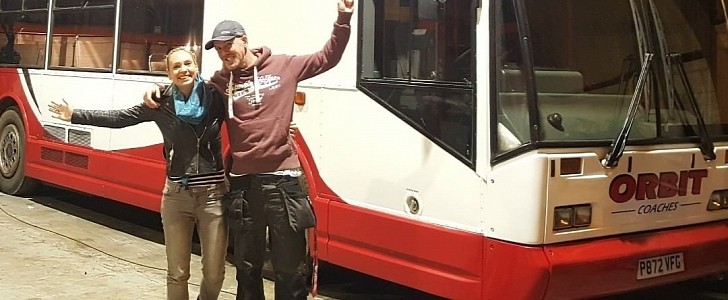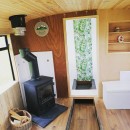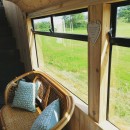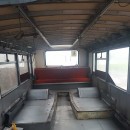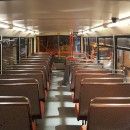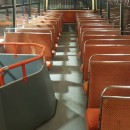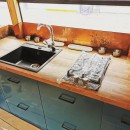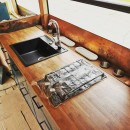The best things in life are free, they say. Most of the time, though, they’re not. Even worse, we often end up paying more than we should for the promise of happiness, or freedom, or peace of mind.
The same applies to the downsizing craze, and specifically to the tiny house movement. The idea for it is very simple and, on the face of it, beneficial to all those involved, particularly the tiny house dwellers and the environment. In reality, potential tiny house dwellers have to pay large amounts of money for the promise of being able to live rent- and debt-free, wherever they may want.
It’s true, even the most expensive tiny house, which can cost as much as $180,000 or $200,000, is still cheaper than a proper, non-moving, average house, but it’s money you have to pay over a shorter span of time, as opposed to regular payments spread across decades. In such a situation, the other alternative for tiny house enthusiasts is the do-it-yourself (DIY) route.
Skoolies, old buses, old trucks and even abandoned vans can make for a good conversion base, as long as there is a decent budget available – and more than a bucketload of skill and spare time. As it happens, one couple from Hereford, UK, had plenty of each, along with the willingness to do their best to create what they hope will be their permanent home on the road.
Gareth and Lamorna Hollingsworth always loved traveling, even before they met – incidentally, abroad, as they were traveling. They got married in 2019 and went on a yearlong honeymoon through Europe in a van, and returned to the UK in February 2020, just as the world was about to shut down in the first attempt to stall the impact of the international health crisis.
They soon decided they wanted to continue traveling and started talking about getting their own van to do so. “Talk of vans quickly became talk of buses, and before long – and after a couple of glasses of wine – we bought a double-decker on eBay,” Gareth, who is a solar panel installer, tells The Sun (more photos from inside the bus are available at the link). “I’ve always wanted to build a house, and the bus was a step in the right direction.”
The double-decker does offer space comparable to a (tiny) house, so the goal was from the start to get it feel like a proper home inside. It took them 2 years and an estimated $27,120 (£20,000) to finish the project, with the final tally including the cost of the 1997 Scania double-decker, the solar panels with the battery and inverter, and the cost of a new driver’s license.
The conversion was a challenge, because they did most of the work themselves, from ripping everything off the old bus to putting in the wiring and choosing the materials for the interior. But the result was well worth the wait: on the ground floor, they have a kitchen with a generous dining area, a lounge area with a wood-burning stove, and a dry bathroom. The upper floor is for the bedroom and an office, another small lounge, and purpose-built wardrobes. The couple did not include options like an additional bed, as most tiny homes do, because they plan on traveling on their own – the dog Maya doesn’t need her own bed.
Another focus in the conversion was to make the tiny home self-sufficient. “Our solar setup gives us nearly four kilowatts of battery storage, enough for almost a week’s usage,” Gareth explains. There’s also a big water tank and a compost toilet on board, so they can go off-grid for longer stretches.
The double-decker is insulated and is finished in wood on the inside, to feel as cozy as a home – or a log cabin, more like it. Every place that could be used for storage is used for storage, including the space under the stairs, which has been repurposed as a pull-out pantry. Personal touches include a bespoke copper backsplash in the kitchen, made from reclaimed copper sheets found and brought all the way from Russia, and stainless steel marine grade rails on the roof to watch the sunset. To keep the project on budget, they used plenty of reclaimed materials and repurposed whatever they could from the old bus.
Gareth and Lamorna are yet to take the maiden voyage in their double-decker but they’ve been keeping a small base of followers updated on the progress on Instagram. They plan to head out for Europe as soon as the conversion is complete, and ultimately settle someplace like Spain or Portugal.
It’s true, even the most expensive tiny house, which can cost as much as $180,000 or $200,000, is still cheaper than a proper, non-moving, average house, but it’s money you have to pay over a shorter span of time, as opposed to regular payments spread across decades. In such a situation, the other alternative for tiny house enthusiasts is the do-it-yourself (DIY) route.
Skoolies, old buses, old trucks and even abandoned vans can make for a good conversion base, as long as there is a decent budget available – and more than a bucketload of skill and spare time. As it happens, one couple from Hereford, UK, had plenty of each, along with the willingness to do their best to create what they hope will be their permanent home on the road.
They soon decided they wanted to continue traveling and started talking about getting their own van to do so. “Talk of vans quickly became talk of buses, and before long – and after a couple of glasses of wine – we bought a double-decker on eBay,” Gareth, who is a solar panel installer, tells The Sun (more photos from inside the bus are available at the link). “I’ve always wanted to build a house, and the bus was a step in the right direction.”
The double-decker does offer space comparable to a (tiny) house, so the goal was from the start to get it feel like a proper home inside. It took them 2 years and an estimated $27,120 (£20,000) to finish the project, with the final tally including the cost of the 1997 Scania double-decker, the solar panels with the battery and inverter, and the cost of a new driver’s license.
The conversion was a challenge, because they did most of the work themselves, from ripping everything off the old bus to putting in the wiring and choosing the materials for the interior. But the result was well worth the wait: on the ground floor, they have a kitchen with a generous dining area, a lounge area with a wood-burning stove, and a dry bathroom. The upper floor is for the bedroom and an office, another small lounge, and purpose-built wardrobes. The couple did not include options like an additional bed, as most tiny homes do, because they plan on traveling on their own – the dog Maya doesn’t need her own bed.
The double-decker is insulated and is finished in wood on the inside, to feel as cozy as a home – or a log cabin, more like it. Every place that could be used for storage is used for storage, including the space under the stairs, which has been repurposed as a pull-out pantry. Personal touches include a bespoke copper backsplash in the kitchen, made from reclaimed copper sheets found and brought all the way from Russia, and stainless steel marine grade rails on the roof to watch the sunset. To keep the project on budget, they used plenty of reclaimed materials and repurposed whatever they could from the old bus.
Gareth and Lamorna are yet to take the maiden voyage in their double-decker but they’ve been keeping a small base of followers updated on the progress on Instagram. They plan to head out for Europe as soon as the conversion is complete, and ultimately settle someplace like Spain or Portugal.
